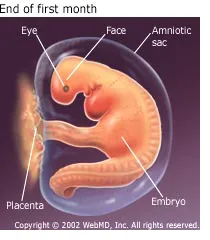If you are newly pregnant or trying to conceive, you have many questions about what to expect. How will your body change? What's happening inside you? Our week-by-week guide will help you through your 9 months of pregnancy so you can be a smarter, more confident, more prepared mom-to-be. Each week offers information about your body and the baby's as well as helpful advice you can use throughout your pregnancy. Let's start with a peek inside the womb.
Weeks 1 and 2
Baby: Your baby is still just a glimmer in your eye. It’s difficult to know exactly when conception occurred, so doctors calculate your due date from the beginning of your last menstrual cycle. That’s right -- for calculation purposes, you’re “pregnant” before you even conceive!
Mom-to-be: The lining of your uterus thickens to prepare for pregnancy. You may notice sticky vaginal discharge during ovulation. At the beginning of your period, about 20 eggs called ova occupy fluid-filled sacs called follicles. If you typically have your period every 28 days, then about 14 days later, you ovulate: One of these follicles releases one or two eggs, which travel down your fallopian tube to await fertilization. This time -- 14 days after your period started and a day or so longer -- is when you're the most fertile. (Note that if you just stopped taking birth control, you may ovulate sooner than expected.) If you want to get pregnant, this is the best time to try. Once the egg is fertilized -- 24 to 72 hours after ovulation -- it moves into the uterus.
Don't be disappointed if you don't get pregnant the first time. Depending on their age, each month, a woman has a 25% chance of getting pregnant, so you may need to try more than once.
Tip for the Week: Make sure you've scheduled a preconception visit with your OB-GYN to determine risks of genetic diseases and environmental hazards as well as learn about necessary lifestyle changes to ensure a healthy pregnancy and baby. Most important, make sure you've started taking 0.4 milligrams, or 400 micrograms, of folic acid a day. Folic acid taken a few months before conception has been shown to dramatically reduce such neural tube defects as spina bifida.
Week 3
Baby: Congratulations! If your egg and your partner's sperm have joined successfully, your embryo is really there, although it's very small -- about the size of the head of a pin. It doesn't look like a fetus or baby; it's just a group of about 100 cells multiplying and growing rapidly. The outer layer of cells will become the placenta, and the inner layer will become the embryo.
Mom-to-be: You won't notice any changes in your body at this point. Remember, you haven't even missed your period yet. But hormones are signaling your body to stop the menstruation process and support your pregnancy.
Tip for the Week: Can't wait to find out? Take a home pregnancy test. They're about as reliable as a urine test or blood test done in the doctor's office -- and you get results immediately. To ensure accuracy, read the directions carefully and make sure all the supplies you use are clean.
Week 4
Baby: Now that your egg is fertilized, it burrows into the lining of your uterus. This is called implantation. It may happen up to 4 days after fertilization.
Mom-to-be: You're probably expecting your period this week, and if it doesn't occur, it might be one of the first signs that you're pregnant. You may also notice light spotting as the embryo implants itself in your uterus. The amniotic cavity, which will be filled with fluid, and the placenta, which will bring oxygen and nutrients to nourish your baby, are forming in your uterus. Your breasts might feel tender and swollen, or you might not feel any different yet. By the end of this week, a home pregnancy test may be positive.
Tip for the Week: Try to eat healthfully, which means choosing a variety of foods from recommended food groups and drinking at least six to eight 8-ounce glasses of water a day. But you don't really need to "eat for two"; you only need an extra 300 calories per day while you're pregnant. And don't worry if your food intake drops in the beginning because of morning sickness. If you've been eating right already, your baby will get what it needs.
What's Happening Inside You?

The fertilized egg grows, and a water-tight sac forms around it, gradually filling with fluid. This is called the amniotic sac, and it helps cushion the growing embryo. The placenta also develops. It is a round, flat organ that transfers nutrients from you to the baby and transfers the baby’s wastes.
A primitive face takes form with large dark circles for eyes. The mouth, lower jaw, and throat are developing. Blood cells are taking shape, and circulation will begin. By the end of the first month, your baby is about 1/4 inch long -- smaller than a grain of rice.
Source https://www.webmd.com/baby/guide/first-trimester-of-pregnancy











3 comments
Slindile
I like to say what can I do ukuba mpofu
Janet faroa
Ek het Julie maand my siek gesien maar August niks en ons is in September maand
Hendrieka
Hi ek wil net gou hoor ek so deer mekaar.wil gou hoor of dit kan wees dat ek swanger is en hou ver. Ek het die 13 januarie 2024 my tyd gehaad en ek en my man her die 27 januarie sex gehaad is ek swanger en hoe ver………………. Ek wil ook net hoor ek het my baba die 18 okt laas jaar op 8 week verloor oor my baarmoeder nie toe gemaak het nie.wat is die kanse dat dit weer gaan gebeer.en wat kan mens doen as dit weer gaan gebeer